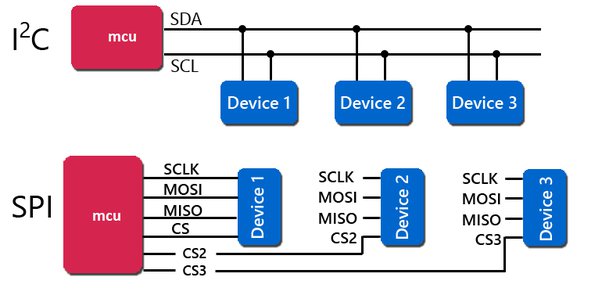Tradeoffs when considering SPI or I2C?

When considering Serial Peripheral Interface (SPI) or Inter-Integrated Circuit (I2C) for a specific application, there are several tradeoffs to consider. Here are some important factors to evaluate:
- Complexity: SPI is generally simpler than I2C in terms of protocol complexity. SPI requires more pins (at least four) compared to I2C (two-wire interface), but it provides full-duplex communication, making it faster. I2C is more complex due to its addressing scheme and arbitration mechanism.
- Speed: SPI is typically faster than I2C. SPI can achieve higher data transfer rates because it operates in full-duplex mode and does not have any bus arbitration overhead. I2C operates in half-duplex mode and has a lower maximum speed compared to SPI.
- Bus Configuration: SPI uses a master-slave configuration where each slave device has a dedicated select (CS) line. In contrast, I2C uses a multi-master configuration, allowing multiple devices to share the same bus. This makes I2C more suitable for applications where multiple devices need to communicate on the same bus.
- Number of Devices: SPI is better suited for connecting a smaller number of devices since each device requires a dedicated select line. In contrast, I2C supports a larger number of devices (up to 127) on the same bus, making it more suitable for complex systems with multiple interconnected devices.
- Hardware Requirements: SPI typically requires additional hardware components, such as shift registers or level shifters, to convert the voltage levels between devices operating at different voltage levels. I2C, on the other hand, has built-in support for voltage level translation, which simplifies the hardware requirements.
- Power Consumption: In general, I2C tends to be more power-efficient than SPI. I2C devices can be put into low-power or standby modes when not actively communicating, whereas SPI devices are typically always active.
- Noise Immunity: Due to its differential signaling, I2C has better noise immunity compared to SPI, which relies on single-ended signaling. This makes I2C more reliable in noisy environments.
- Application Compatibility: Consider the specific requirements and compatibility of the devices you intend to interface with. Some devices may only support one of the protocols, and selecting the appropriate one is crucial for compatibility.
Ultimately, the choice between SPI and I2C depends on the specific needs of your application, including factors such as speed, complexity, number of devices, power consumption, and compatibility requirements. It is important to carefully evaluate these tradeoffs to make an informed decision.
mixos Edited answer 7 June, 2023

